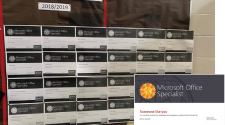 Online learning has become a big phenomenon in the last 10 years, and individuals, institutions and professionals are embracing its possibilities.
Online learning has become a big phenomenon in the last 10 years, and individuals, institutions and professionals are embracing its possibilities.
E-learning is a great solution for people who are juggling different responsibilities and are trying to find a balance between school, work and other life demands. It also allows students from abroad to take courses in a different country. Educators now tend to get excited rather than surprised when they have 70-80 percent of students in their online classes coming from out of town.
One of the questions that educators often ask, however, is how to make online learning effective for the students. What format and class styles would work better for them?
Synchronous Learning
Teaching online, I have noticed 2 major differences between the in-class and e-learning. The first difference is creating the community feeling: students generally feel more connected in the in-class format and have more opportunities for engagement. The second one is that in class, the instructors have the benefit of observing the body language quicker. This allows them to react when the students are losing focus or getting distracted.
It used to be that online education did not provide the same learning environment as in-class, but that has changed with the transition towards synchronous learning.
Synchronous learning refers to online interactions between the instructor and the students that happens in real time in a live online format. Synchronous learning becomes a way to have the benefits of the traditional classroom environment in the comfort of one’s home.
1. It helps the instructor facilitate the lesson.
With various web- and video-conferencing tools, instructors and students have an advantage of real time lectures. Instructors can see all the students, the lecture slides are on the screen, and students can use microphone and chat box for communication. It is easy to organize the lecture and have clearly communicate with the class.
2. It drives student engagement and collaboration
In synchronous format, students have multiple opportunities to interact, communicate and collaborate. In fact, the web-conferencing tools often have different options on how to setup the screen depending on the presentation style you want. If the instructor wanted to drive collaboration or encourage students to share their experiences, they can reorganize the screen with one click, arranging students into groups or making them the main presenters. I often do that in my online classes.
3. It is motivating
Many students have shared that they prefer live online formats because they don’t feel like they would be able to find the motivation and energy to study by themselves. By attending a live webinar, students stay motivated and focused on their studies. They also have multiple opportunities to clarify the materials in real time, as the lecture is presented.
Asynchronous Learning
Synchronous learning model is not the only one that is available. Many students who take online classes do so to be able to have a better of work-life balance. If they know they have enough self-discipline to study in their own time, they may want to opt in for something that allows them to learn asynchronously.
Asynchronous learning environment allows online interactions to occur at different time periods, according to the students’ and instructor’s own schedule.
1. It creates a better work-life balance.
It is a great opportunity for the students take control of their learning. The students and the instructor can still collaborate and communicate through various online tools (emails, web-based apps, messaging tools, etc.) that do not require them to continuously stay online. Students can take their own time on the assignments and school activities, allowing for a greater work-life balance.
2. It doesn’t require extra technologies.
Asynchronous learning often uses simple tools that are free and do not require extra hardware or software installation. It is an easy tool that can be used at the students’ and instructor’s convenience.
3. It drives student-centered education.
Students have an opportunity to personalize their education: they can actively participate in their own learning. Asynchronous classes are typically text-based, allowing the students to take their time in their analysis, comments and reflections.
Which One to Use?
It is clear that there are many helpful and practical tools for e-learning education, and the future is behind online education. Each study environment comes with its strengths and weaknesses, and some people prefer one over the other, depending on what fits with their learning style.
I personally believe that incorporating both synchronous and asynchronous tools into e-learning is the best solution for online classes. Students who cannot attend the webinars should be able to watch the recording; and students who prefer to study on their own should still be able to have live online time with their instructor and the classmates.
At the end of the day, however, the most important thing is to use the interactive online tools for the classes. Students should have opportunities to interact with the instructor, express their ideas, ask questions and comment on the class materials. With so many online tools available, we should take advantage of them in our education system.
About the Author
Amr Shokry is a global Human Resources (HR) leader with 20 years of senior leadership experience in Canada, USA and Europe. Amr currently teaches the Diploma in Human Resources Management program at Ashton College.






No Comment